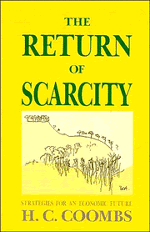Book contents
- Frontmatter
- Contents
- Introduction
- 1 Towards a Sustainable Society
- 2 Scarcity, Wealth and Income
- 3 Matching Ecological and Economic Realities
- 4 Science and Technology - For What Purpose?
- 5 Economic and Ecological Issues in Resource Management
- 6 Resource Management and Environmental Law
- 7 The Quality of life and Its Assessment
- 8 Is Democracy Alive and Well?
- 9 Technology, Economic Change and Political Strategy
- Bibliography
7 - The Quality of life and Its Assessment
Published online by Cambridge University Press: 05 August 2012
- Frontmatter
- Contents
- Introduction
- 1 Towards a Sustainable Society
- 2 Scarcity, Wealth and Income
- 3 Matching Ecological and Economic Realities
- 4 Science and Technology - For What Purpose?
- 5 Economic and Ecological Issues in Resource Management
- 6 Resource Management and Environmental Law
- 7 The Quality of life and Its Assessment
- 8 Is Democracy Alive and Well?
- 9 Technology, Economic Change and Political Strategy
- Bibliography
Summary
Paper given at the Sixth Conference of Economists, University of Tasmania, Hobart, May 1977. University of Tasmania Occasional Paper 11.
ECONOMISTS and others have come increasingly to doubt the assumption implicit in so much of their analysis and advice that increased production is a direct and approximately proportionate addition to human well-being. Their doubts arise partly from awareness of costs, particularly of an environmental kind, which are ignored in market processes. They arise more fundamentally from an awareness that the market provides only part of the components of any lifestyle. Increasing attention, therefore, has been directed in recent years to the concept of the quality of life and to the search for ways of assessing it.
My own doubts have been influenced by my experience, direct and vicarious, with contemporary Australian Aboriginal communities. Traditionally these communities engaged in little production but depended on harvesting the natural products of the land and its waters. They neither tilled nor seeded the earth; they domesticated only the dingo and their tools were few.
It has been common to assume that their way of life was poor and degraded - ‘nasty, brutish and short’. Yet social scientists have shown that while it was dependent on strict control of numbers and the average lifespan was short, those who survived infancy were usually healthy, vigorous and self-reliant. Furthermore, they have shown that this lifestyle was compatible with diverse physical and intellectual activity and a rich cultural experience.
- Type
- Chapter
- Information
- The Return of ScarcityStrategies for an Economic Future, pp. 107 - 127Publisher: Cambridge University PressPrint publication year: 1990



